When a tree falls in a forest it makes a sound, we can be very sure about this – fibres snap and branches break, air is moved and energy released. All of this happens if we are there to hear it or not. Sound is just vibrations in air. But if a tree falls in space, then it wouldn’t make a sound… but if there was a tree falling through space there would be some more pressing questions to ask.
On my first day back at work, I was called to inspect a tree where a branch had suddenly dropped off it. Thankfully the sound it made alerted the family under it, the father heard the noise, grabbed his kid and ran, the branch came down and squashed the seat they were on – squashed it flat! They were completely unharmed, and by all accounts completely unfazed; ‘no worries, we were about to leave anyway’
What happened was Summer Branch Drop (SBD). It was a beautiful summers day, hot, dry and not a breath of wind. The tree (an ash) was situated in a park, very near to a child’s playground, it was the weekend, the park was full of people and there were people under the tree at the time.
It would be true to say that it was lucky that nobody was harmed, yet it would also be fair to say that, those that saw it were very lucky; very lucky indeed, SBD is uncommon. I wonder how many of those that saw it actually know how lucky they were?
The phenomenon known as Summer Branch Drop (SBD) occurs in a wide range of tree species; ash, oaks, elms, eucalyptus, pines and poplar to name a few. When and why it happens, no one is quite sure. SBD appears to be associated with calm conditions and high temperatures, but summer branch drop isn’t confined to summer – many people call it Sudden Branch Drop (SBD).
A quick literature search will reveal little agreement as to the cause of SBD, most experts happy to point out why other theories are wrong, but very few will say that their theory is right. Some say it happens because the tree soaks up too much water during hot summer days and the branches become too heavy, others say it is cell shrinkage caused by heat. There is a theory that it is triggered by high humidity within the tree’s canopy, leading to a surplus of moisture that weakens the tree’s structure. There are several ideas about internal cracks; microscopic or hairline longitudinal cracks focused on the dorsal side of the branch. It could be ‘sap steaming’ caused by the sun leading to cell expansion, or maybe increased root pressure (caused by atmospheric pressure) forcing moisture into the tree, or increased gas production (ethylene, leading to localized growth or and/or methane produced by wet-wood bacteria simply pumping the cells up).
There are theories a-plenty but facts a-few, SBD is indeed a mysterious occurrence.
The trees tend to be generally healthy, often the failed branch reveals no obvious external defects. Failures typically occur a short distance from the branch union, mainly on horizontally growing branches, and usually during the late afternoon. The breaks are typically short and at right angles to the axis of the branch, the inner wood is broken bluntly with no sharp splintering. Because failure occurs unexpectedly without wind load, the material properties of the branch must change, which supports the crack theory. These changes in wood properties are most likely related to changes in hydrology, which adds weight to the water loading and/or cell size theories, but from there nobody knows for sure.
My tree ticked most of those boxes. The tree was full of holes so the sap-wood was stained, but the area where the beak occurred was free of obvious structural defects. Several prominent and exceptionally knowledgeable arborists had looked at the tree in the weeks before the failure happened, and while none of them technically assessed the tree, none of them expressed any concern – I didn’t pick it, and I am confident there was nothing obvious to be seen.
So how do you predict, something that can’t be predicted and how do you inspect for something that can’t be seen? You don’t, you don’t because you can’t. You can’t because we don’t know why, and because we don’t know why, when becomes pointless. On the flip side, because we don’t know why and because it can’t be predicted (with any real accuracy), you can’t really be held to account for missing it either.
SBD is fascinating, and just a little bit scary.

0 Comments